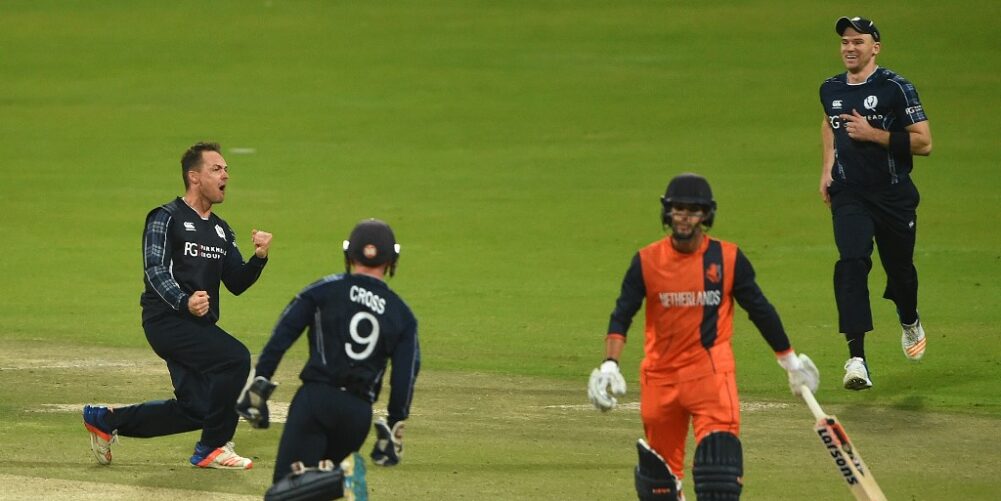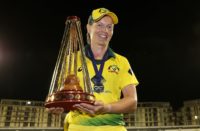(Photo: Getty Images)
By Tim Wigmore
As with all the best ideas, in hindsight, the wonder of the Desert T20 tournament is that it has taken so long to come about.
This year’s inaugural tournament, which concludes with finals day tomorrow, follows a refreshingly simple format: two groups of four, with the top two nations in each advancing to the semi-finals. As such, every match matters, and, in a age marked by bloated sports tournaments, it will be all over and done within eight days.
So far, the tournament has highlighted much of the best of Associate cricket. It has reaffirmed that T20 is the best avenue for the globalisation of the sport, although this should be seen as a gateway to the other formats, not coming at the expense of them.
It has shown that Associates are capable of some wonderful cricket in the format but, more than anything, it has served as affirmation of the burgeoning depth of their cricket.
It often seems to be thought, not least by cricket’s governing elite, that Associate cricket begins and ends with Afghanistan and Ireland. The notion, if it was ever true, is badly dated. In the 2015 World T20 qualifiers, neither of the giants made the final. In 2016, Ireland were toppled by Oman in the World T20. While both qualified from their groups to make the semi-final of the Desert T20, Afghanistan could easily have been beaten by the UAE, and Ireland by Namibia.
Yet it was the other group, featuring Hong Kong, Netherlands, Oman and Scotland, that really showcased the best of Associate cricket. Hong Kong, the Pakistan of the Associate world, responded to a thumping defeat by Oman by thrashing, and eliminating, the Dutch, who have beaten England two times out of two in the WT20. All of this goes to show what Associate cricket can bring to the global game. The first Desert T20 should just be the start.
The tournament, brainchild of Will Kitchen, ICC Academy general manager and performance manager for UAE cricket and the ICC’s high performance programme, is fundamentally an attempt to remedy the Associates’ crippling lack of cricket, especially for those beyond Afghanistan and Ireland.
The Netherlands’ underwhelming performances can somewhat be explained away by their derisory schedule – just three internationals – in the ten months since they were eliminated in the first stage of the WT20 last year. Ultimately, international cricketers can only improve so much without actually playing.
This tournament also amounts to a break from the cut-throat world of Associate cricket, in which virtually all matches count towards qualification for world events or funding that, in practice, often determines whether or not players can remain professional. The Desert T20 is different – there is a trophy to be won and, while all sides are desperate to lift it, the nature of the tournament also enables sides to experiment a little, and introduce young players to build for the long-term.
Unlike in normal ICC events, the losers do not face crippling the future of the sport in their country.
But there is much more that should be done. For a start, the tournament should be streamed. Because of the complex nature of the ICC’s commercial rights deals, and the rather last-minute nature of the tournament – the schedule was only finalised a fortnight before the opening game – no live-streaming was possible.
That is a deep shame, given the popularity of recent Associate T20 events – the first stage of the 2016 WT20 and the qualifiers – which was so great that it surprised many in the ICC.
But it is likely that the tournament will become an annual event and in future all games will be live-streamed. If it is promoted well, then the Associates T20 could become not merely a vehicle for Associates to gain much-needed match time against each other, but also to promote the sport.
Ultimately, it should be seen as an event for the Associates to generate money for themselves, which they can then invest into growing the game in their countries. Until a few years ago, the WT20 qualifiers were subsidised by the ICC, but they are now considered a sufficiently attractive prospect as to make money in their own right, showing what is possible.
Ideally, the Associates T20 event would take place twice every year – perhaps once in the UAE, with the other event moving between different nations. It is not as if the time to do this does not exist: even with several days of preparation time, teams will return home a fortnight after leaving.
Two tournaments a year would enable the tournament to generate a narrative of its own, just like the travelling rugby Sevens tournament, which should be the model. Rivalries and history would develop, while sponsors and commercial partners would gain certainty about the event and its place in the cricketing calendar. In time, perhaps the weaker Full Members – above all Bangladesh and Zimbabwe, who both rejected invites for this year’s Desert T20 – could be persuaded to join, too.
A number of Full Member A sides have also expressed an interest in sending teams to future editions, though it is a tricky subject: is Associate cricket undermined by allowing tournaments to feature representative teams, rather than full national sides, from other countries?
And, I understand that there are plans for the Desert T20 format to be mirrored at 50-over level, too. This would also be overdue: it would provide much-needed competitive 50-over cricket for the top Associates, and also, crucially, ensure that ODIs are played between Afghanistan and Ireland and the next batch of Associates, something that has not happened at all since the two were elevated to the elite 12-team ODI structure in 2012.
Just as Afghanistan and Ireland need to play against sides ranked above them to improve, so the same is true for Hong Kong, Netherlands, Papua New Guinea, Scotland and other top Associates, which is why ODIs against Afghanistan and Ireland would be so significant.
A new 50-over Associates competition would also help to prevent emerging nations from prioritising T20 cricket at the expense of other formats, and thereby adding to the case for the World Cup to be expanded beyond 10 teams. The leading Associate countries and players are committed to ODIs, but while they play so little of it – 14 matches between 2015 and the end of 2017 in the WCL Championship – they scarcely have the chance to improve.
So planning for the Desert T20 to become an annual – or biannual – event, while introducing a 50-over tournament along the same lines, will give Associates the best chance of toppling Full Members when given the chance.
More importantly, it allows top Associate players the chance to improve, and the Associate game to gain new profile – not merely as an adjunct to games between Test nations, but as engrossing, meaningful sport in its own right.















